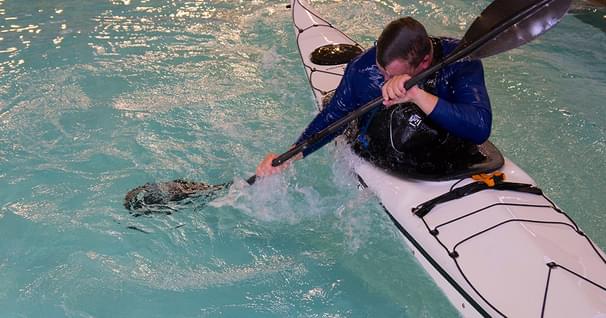Essential Paddle Strokes for Women
Now I'll try and describe how to do the strokes you need to make your boat go where you want to take it. Once you've read these descriptions and looked at the pictures, get out on the water and give it a try! It can be good to practice new strokes with a paddling buddy because they'll be able to see what you're doing and offer helpful corrections and encouragement. Nothing can really replace the benefit of on-water instruction, but this will certainly get you started, and can serve as an on-going post-lesson reference guide.
Forward Stroke The forward stroke is the stroke you'll use most often to get you where you want to go. A good forward stroke has four different parts: the wind up, the catch, the torso rotation and the finish.
Before getting into each part of the forward stroke I'd like to emphasize the importance of sitting up straight when you paddle. Unfortunately people assume that leaning back on your backrest or even having the back of your kayak seat leaning back is more comfortable and alleviates back pain. This is another major myth to be busted. Leaning back actually causes back pain and hinders your ability to paddle properly. The back rest of your kayak seat should be tight enough to assist your abdominals in helping you to sit up straight. So, tighten the back band up until you're sitting nice and straight - as straight as possible. Lift your chest; keep your head up and your gaze ahead. Proper posture reduces fatigue and helps you generate the most power for your strokes.
For a more powerful, faster and aggressive forward stroke you want to plant your paddle by your feet with the blade of the paddle right up against the bow of your kayak. In this position your paddle will be close to vertical and if you gently lift your gaze you'll be able to see your wrist. For a relaxed and easily sustainable forward stroke, your top hand should be held at about chest, neck or chin level, depending on what feels comfortable for you, and you'll notice that your paddle will be more horizontal, although not so horizontal that it's parallel with the water. These positions are called the plant position - the starting point for your forward stroke.

To get the most reach possible you'll want to wind up your torso by twisting your navel toward the opposite side that you're going to plant your stroke-if you're going to plant your paddle on the right, twist you navel toward the left, or vice-versa. What this does is give you more reach and wind up your torso so that it's ready to unwind and provide power for your stroke.
Next, plant your paddle blade squarely in the water, and remember to imagine that you're planting it in something solid. This part of the stroke is called the catch, because it's when you catch the water against the face of your paddle blade. Now is the time to concentrate on the "plant and rotate" concept as you move.
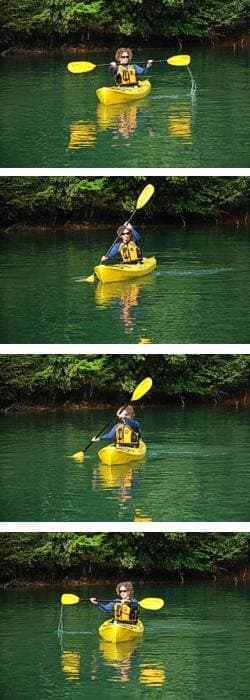
Starting at your navel, unwind your torso and remember not to pull with your arms- allow the torso to do the work. Finally, once the blade is past your hip remove the blade from the water.
What you'll notice is that by rotating your torso all the way through to the point where you remove your paddle blade from the water, you've set yourself up perfectly with a wound-up torso for the next stroke.
Once you've got the basic movement down, you can put some polish on your forward stroke, by concentrating on keeping what is called a "quiet boat". A quiet boat is one that doesn't bob up and down from side-to-side or front-to-back with each stroke. With practice, and by focusing on rotation, your forward stroke will start to feel very smooth and graceful.
TIP
To find out if you're using your arms too much when you paddle try straightening both arms, locking out the elbows and trying to paddle with your arms totally straight. If you have a hard time doing this then you're probably pulling and using too much arm strength instead of rotating your torso. Straight arm paddling is a great exercise to help you get the feel for rotation because the only way you can actually paddle with straight arms is if you rotate your torso.
 Going in Reverse - Back Strokes
Going in Reverse - Back Strokes
The back stroke is the reverse of the forward stroke, but the technique isn't as precise. Most paddlers neglect the back stroke when, in fact, it's an important stroke to do from time to time to use complementary muscles in your shoulders. I recommend that you throw in a little back paddling into every kayak outing just to keep your shoulders limber. Additionally, you never know when the back stroke will help you get out of a tight corner, so it's a good idea to practice it.
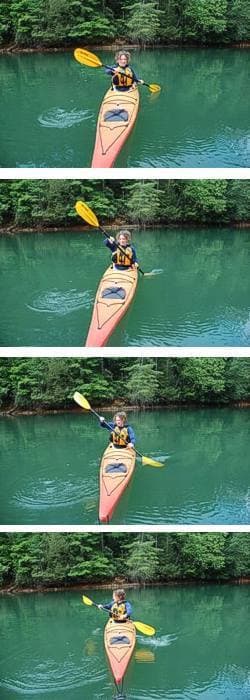
To start the back stroke, wind up your body by twisting your navel back on the side of the kayak where you're going to initiate your stroke. In the back stroke the wind-up also helps you to reach back past your hip so that you can plant your paddle in the water. Use the backside of your paddle blade, not the power face-there is no need to change your hand positioning or twist your paddle shaft around in your hands.
After you reach back and plant the paddle behind your hip, unwind your torso until the blade reaches close to your feet. The blade moves alongside your boat. As with the forward stroke, you'll find that removing the blade near your feet leaves you with your torso wound-up for the next back stroke.
TIP
Be careful not to lean back to initiate the back stroke. Rotating back instead of leaning back will help you to maintain good posture and balance, and will give you more power in your stroke. Rotating back also lets you take a quick peek over your shoulder with each stroke so that you can see where you're going!
Turning Your Boat - Sweep Strokes
Sweep strokes are a quick and easy way to turn your boat to the right or left. You can use sweep strokes when you are moving forward or backward, or from a stationary position:
Forward Sweep Strokes
A sweep stroke on the right side of your boat will turn it to the left; a sweep stroke on the left side of the boat will turn it to the right. You can also use a sweep stroke intermittently with regular forward strokes for the purposes of course correction.

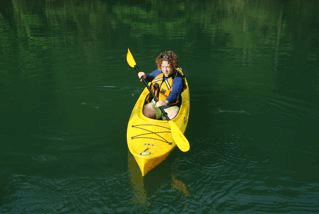
Keep the angle of your paddle shaft fairly low, so that it is close to horizontal. Place one blade out in front of you, near your toes, so that the initiating arm is almost completely extended. The other arm should be bent with the blade back near your hips. Wind up your body by rotating your navel toward the bent arm, and notice how doing this allows your extended arm to reach a bit further. Plant your paddle blade in the water, sinking the blade fully into the water. Next, using your core muscles, unwind your body so that you trace a half-moon in the water from the bow of your boat towards the stern. It helps to keep your arms fairly stiff as you do this to ensure that the power comes from your core, not your arms. It is also useful to keep your eyes on the paddle blade as it moves through the water. Finally, pull your paddle out of the water a few inches before it reaches the side of your kayak-if you hit the side of your boat with the blade, it can make you unstable.
Practice this on both sides to get a feel for how your boat moves in the water, and to discover how little effort it takes to turn your kayak. Recreational, sea and touring kayaks are designed to go straight, so it will often take more than one stroke to turn them - and the more powerful your torso rotation, the easier they are to turn.
Reverse Sweep Strokes
A reverse or back sweep stroke on the right side of your boat will turn it to the right; a reverse sweep stroke on the left will turn the boat to the left.
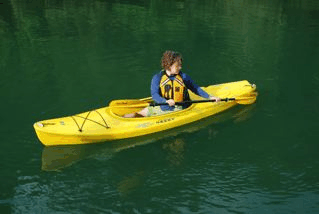
To do a back sweep stroke, wind up your torso by twisting your navel back toward the stern of your boat. Keeping your hands low and your paddle shaft almost horizontal, reach back with your blade and plant it in the water near your kayak. Note that you are just using the backside of your blade for this stroke-don't worry about twisting your paddle in your hands to use the power face. After you plant your paddle, unwind your body by turning your navel back toward the bow of your kayak, remembering to use your core muscles. Follow the arcing path of your active paddle with your eyes, and remove the paddle a few inches from the front of your kayak.
TIP
To turn your boat 180 degrees fairly quickly, alternate a forward sweep stroke on one side of your kayak and then a reverse sweep stroke on the other side. Repeat until you have spun around!
I have explained good technique for the most basic paddling strokes needed to enjoy your outing on the water. Practicing good technique will make you fitter, stronger and will create better alignment and health for your back, neck and shoulders. Not to mention that it will make paddling feel effortless and fluid. Now that you know that kayaking isn't all about strength - happy paddling and stay tuned for more advanced stroke and edge control technique!
Anna Levesque is a world-class kayaker who has a passion for inspiring and teaching women. Her experience as an accomplished international competitor, author, instructor and business owner has placed her as the leading expert in her field. Her top accomplishments as a whitewater athlete include a bronze medal at the 2001 World Freestyle Kayak Championships, a spot on the Canadian National Freestyle Team five years in a row, and many top 3 finishes in both Freestyle and Extreme Racing. Anna combines her international expertise in kayaking with her experience as a yoga instructor and student of meditation, to inspire women in confidently creating success and happiness in all aspects of their lives. She offers women's paddling retreats, clinics and trips in Mexico through the her company, Girls at Play, and the Nantahala Outdoor Center. For more information please visit www.watergirlsatplay.com
Related Articles
By changing how you edge and balance your boat you can increase your stability and adaptability. Using…
Mention “pool session” and the first image that pops into most kayakers minds is a class in how to roll.…
Photo Credit: Darlene Patterson Many people who have paddled for years can't keep a canoe on a straight…
Most people are concerned with how to get their standup paddle board moving forward, but it's just as…

